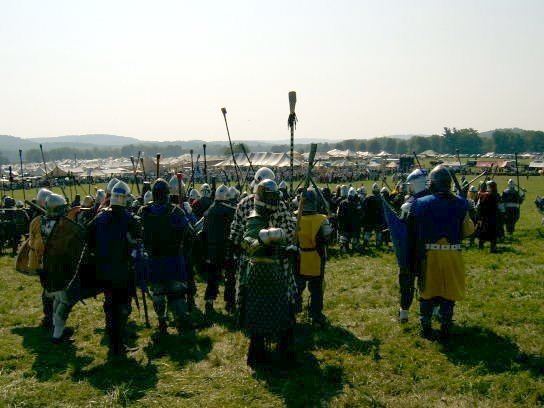 | ||
The Pennsic War is an annual American medieval camping event held by the Society for Creative Anachronism—a "war" between two large regional SCA groups: the Kingdom of the East and the Middle Kingdom. It is the single largest annual SCA event, with more than 10,000 people attending each year, from as far as Sweden, Germany, France, Italy, Greece, and Australia.
Contents
Pennsic is held in late summer and lasts for 17 days (begins on a Friday, ends on the second Sunday). The event centers on pre-17th century history and culture with all campers dressing in medieval clothing. The winners of the battles and other activities receive war points, and the Kingdom with the most war points wins that Pennsic.
The name Pennsic War is a combination of Pennsylvania and Punic War. The Pennsic War uses numbers to identify each war rather than the year it was held, so the 2011 event was known as "Pennsic War 40", there having been 39 previous events.
History
The Pennsic War takes place in late July/early August. Prior to 2007, Pennsic took place during the first two weeks of August, and some of the earliest Pennsics were held during September.
This is celebrated in song by performer Duke Moonwulf Starkadderson in "Pennsic War IV".
According to the HERSTAĐR-SAGA: An Incomplete History of Pennsic,
One day, almost 30 years ago, Cariadoc of the Bow, the King of the Middle, got bored with peace and declared war upon the East, loser to take Pittsburgh. The King of the East read the declaration of war, filed it away and forgot about it. Time passed. Cariadoc moved to New York and subsequently became King of the East, whereupon he retrieved the declaration from the file cabinet and said, "Let’s fight." The Middle won, and Cariadoc has the distinction of being the only king who declared war upon himself and lost.
Contrary to popular myth, the Pennsic wars were not caused by Cariadoc challenging himself to a war and losing. The challenge for the Pennsic war was initially issued by King Irial and Queen Morna of the Middle, with the stated causes being both the ownership of the new group forming in Pittsburgh, the Debatable Lands, and an earnest desire to have fun and "engage in chivalric combat of the highest". The letter containing the challenge along with an arrow of war was carried by Duke Cariadoc, as a herald of King Irial, to King Rakkuri and Queen Maureen of the East who accepted the challenge, and broke the war arrow. The negotiations for the war, locating a suitable site, determining the rules for combat and scenarios for the battles, etc. dragged on long enough that by the time the war was actually held, neither Irial and Morna nor Rakkuri and Maureen were still on the thrones. The Midrealm was ruled by Andrew and Anne, and the East was ruled by Cariadoc and Diana, who had moved to the East during the negotiations.
The board of directors ruled a few weeks before Pennsic I that since Pittsburgh was in the same state as an existing group, in Philadelphia, that it had to belong to the same kingdom. It was considered impossible to split a state between two kingdoms at that time. Thus, the Debatable Lands were assigned to the East Kingdom prior to Pennsic being fought, which rendered moot the initial reason for the war. Since the stated purpose of the war was to determine which kingdom got Pittsburgh and the Midrealm decisively won Pennsic I, it became popular mythology that "the loser got Pittsburgh."
People
Since Pennsic XXV in 1996 the event has gathered over 10,000 participants most years. These include not only SCA members from across the globe, but also members of various other historical re-enactment groups such as Markland; and martial arts–based organizations, such as the Tuchux or Rome. Pennsic is, however, an SCA event; members of other groups are welcome, but are generally expected to follow SCA rules—especially in regards to armor, weapons and behavior on the battlefield for the various fighting scenarios. According to the official Pennsic website, the final count for 2015 was 10,556.
Martial
Non-martial
Local impact
With over 10,000 people, Pennsic becomes the fourth largest populated place in Butler County, PA (after Cranberry and Butler Townships, and the City of Butler). Pennsic's annual economic impact on the immediate area amounts to $1.8 million dropped into the Butler County economy, with many local businesses citing the period during Pennsic being among their busiest of the year.
